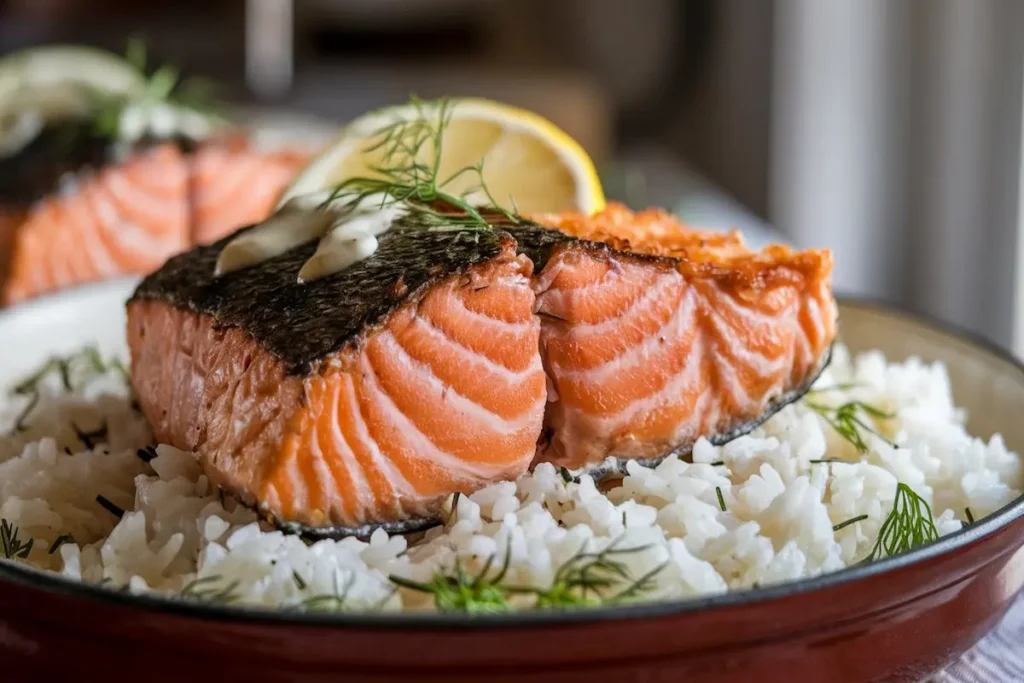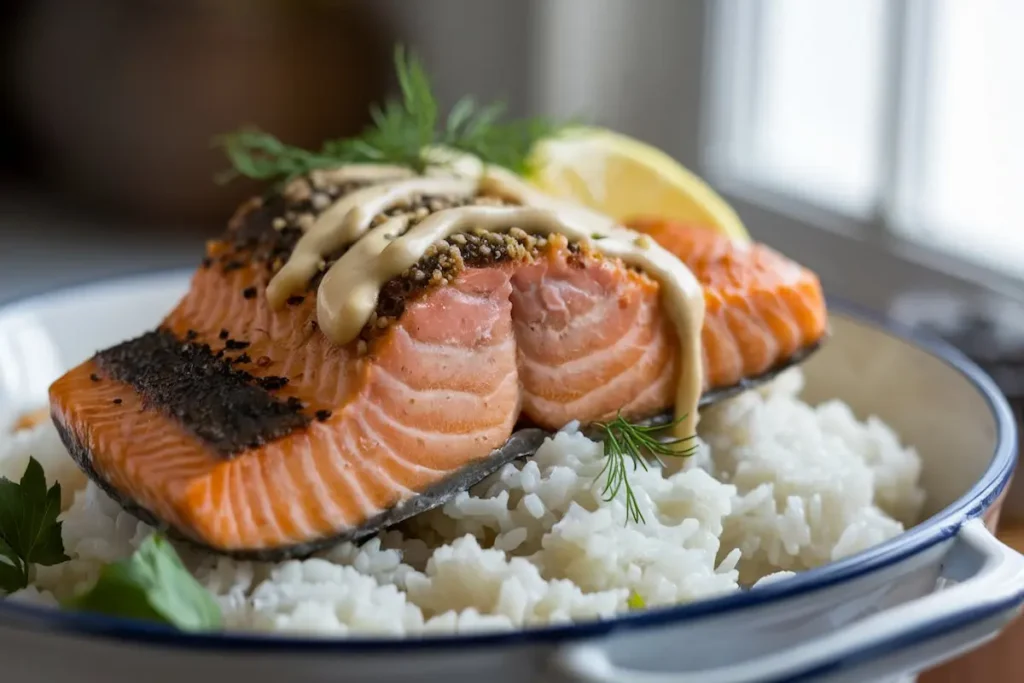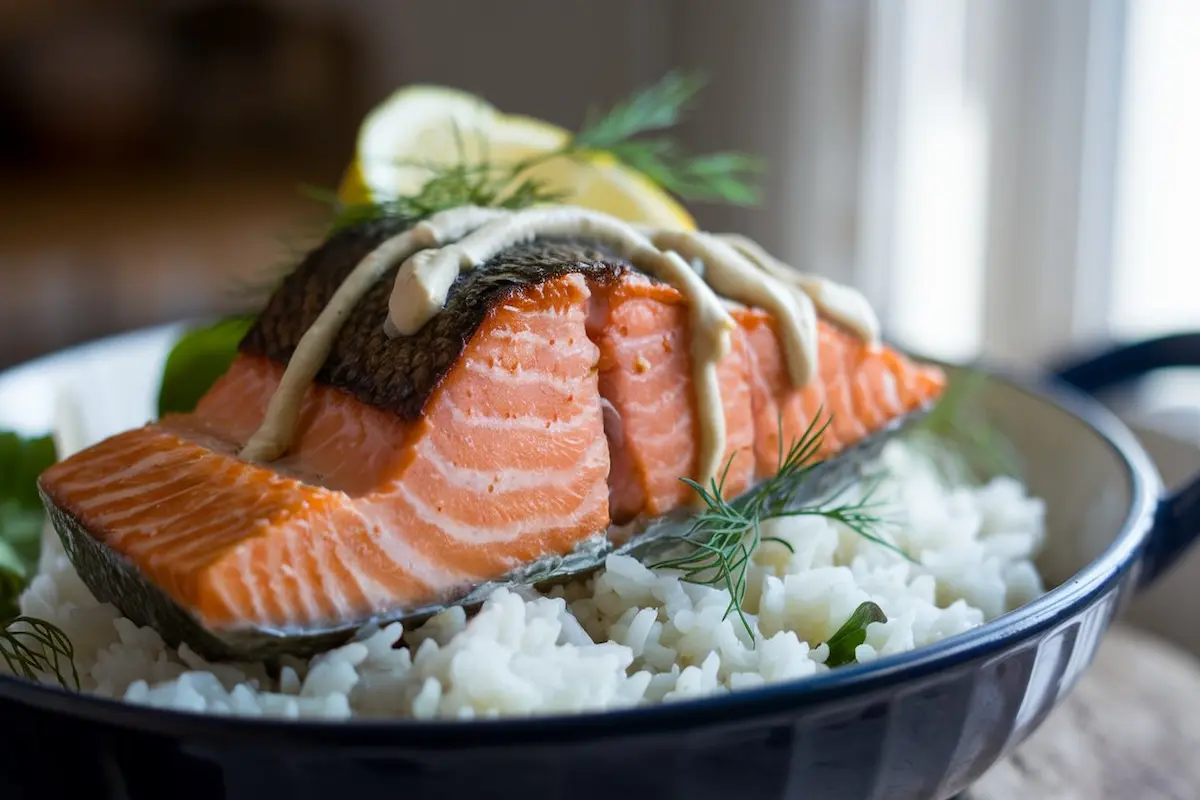Introduction
Salmon and Rice Recipe is a classic combination that has been cherished across the globe for its simplicity, flavor, and nutritional benefits. Whether you are looking for a quick weeknight dinner or an elegant meal to impress guests, this dish is versatile enough to fit any occasion. In this comprehensive guide, we’ll explore the best methods to cook salmon, the different types of rice that pair well with it, and how to elevate your dish with various sauces and sides. Get ready to dive into the world of salmon and rice and discover a meal that’s not only delicious but also packed with health benefits.
1. Choosing the Right Salmon
When it comes to making the perfect salmon and rice dish, the first step is choosing the right salmon. There are several types of salmon available in the market, and each offers a unique flavor and texture. Here’s a breakdown of the most common types:
- Atlantic Salmon: Known for its mild flavor and rich texture, Atlantic salmon is a popular choice for many recipes.
- Sockeye Salmon: This variety is known for its deep red color and robust flavor, making it perfect for dishes that require a stronger taste.
- King Salmon: Also known as Chinook, this is the fattiest and most flavorful type of salmon, often considered the king of all salmon varieties.
- Coho Salmon: With its milder flavor, Coho is great for those who prefer a less intense taste but still want the benefits of salmon.
Pro Tip: When purchasing salmon, always look for wild-caught varieties as they tend to have a better flavor and are more sustainable.
For those interested in exploring other protein options, check out our Ultimate Rotisserie Chicken Recipes for a delightful alternative that’s just as versatile.
2. Preparing the Salmon
Preparing salmon properly is crucial to achieving the perfect texture and flavor. Here’s a step-by-step guide:
Marinating the Salmon
Marinating your salmon adds a burst of flavor that can complement the natural taste of the fish. Here’s a simple marinade recipe:
- Ingredients:
- 2 tablespoons olive oil
- 1 tablespoon lemon juice
- 2 cloves garlic, minced
- 1 tablespoon soy sauce
- 1 teaspoon honey
- Salt and pepper to taste
- Instructions:
- In a bowl, combine all the ingredients and mix well.
- Place the salmon fillets in a resealable bag or shallow dish.
- Pour the marinade over the salmon, ensuring all pieces are well-coated.
- Marinate for at least 30 minutes, or up to 2 hours for a deeper flavor.

Cooking Methods
There are several ways to cook salmon, each bringing out different aspects of the fish’s flavor and texture.
- Grilling: Ideal for those who enjoy a smoky flavor. Preheat the grill to medium-high heat and cook the salmon for 4-6 minutes on each side.
- Baking: A healthier option, baking allows the salmon to cook evenly while retaining moisture. Preheat your oven to 400°F (200°C) and bake the salmon for 12-15 minutes.
- Pan-Seared: This method gives the salmon a crispy exterior while keeping the inside moist. Heat a non-stick pan over medium-high heat, add a bit of oil, and cook the salmon for 4-5 minutes on each side.
- Poaching: Poaching in a flavorful broth keeps the salmon tender and moist. Bring a pot of broth (chicken, vegetable, or fish stock) to a simmer, add the salmon, and cook for 10 minutes.
If you’re looking for another way to cook protein with minimal fuss, our Ultimate Guide to Baked Beans offers an excellent resource for slow-cooked flavors.
3. Choosing the Perfect Rice
Rice is the perfect companion for salmon, providing a neutral base that allows the fish’s flavor to shine. Here are some popular types of rice to consider:
- White Rice: A classic choice, white rice is fluffy and light, pairing well with the rich flavors of salmon.
- Brown Rice: Healthier and nuttier in flavor, brown rice is a whole grain option that adds texture to the dish.
- Basmati Rice: Known for its aromatic flavor, basmati rice is a long-grain variety that complements salmon perfectly.
- Jasmine Rice: This fragrant rice has a slightly sticky texture, making it a great option for dishes that require more moisture.
- Wild Rice: Not actually rice but a seed, wild rice offers a chewy texture and a nutty flavor that pairs beautifully with salmon.
Cooking the Rice
- Ingredients:
- 1 cup rice (your choice)
- 2 cups water or broth
- 1 tablespoon butter or olive oil
- Salt to taste
- Instructions:
- Rinse the rice under cold water until the water runs clear.
- In a medium saucepan, bring the water or broth to a boil.
- Add the rice, butter or olive oil, and salt.
- Reduce the heat to low, cover, and simmer for 15-20 minutes, or until the rice is tender and the water is absorbed.
- Fluff the rice with a fork and serve alongside the salmon.
For a twist on traditional rice dishes, you might want to explore our Dirty Rice Recipe, which brings a burst of Creole flavors to your table.
4. Enhancing Your Dish with Sauces and Sides
To take your salmon and rice dish to the next level, consider adding a sauce or side that complements the flavors. Here are a few suggestions:
Sauces:
- Lemon Butter Sauce: A simple yet flavorful sauce made by melting butter with lemon juice and zest.
- Dill Yogurt Sauce: Combine Greek yogurt with fresh dill, garlic, lemon juice, and a pinch of salt for a creamy accompaniment.
- Teriyaki Sauce: A sweet and savory sauce made from soy sauce, mirin, sake, and sugar, perfect for an Asian-inspired dish.
Sides:
- Steamed Vegetables: Broccoli, asparagus, or green beans are excellent choices that add color and nutrients to your meal.
- Roasted Potatoes: Crispy on the outside and soft on the inside, roasted potatoes are a hearty side that pairs well with salmon.
- Salad: A fresh green salad with a light vinaigrette can balance the richness of the salmon.
For those interested in pairing their salmon with a delightful pizza, try our Chimichurri Tomato Pizza Recipe for a vibrant and tangy side option.
5. Pairing Your Meal with the Right Beverage
No meal is complete without the perfect beverage to complement the flavors. Here are some pairing suggestions:
- White Wine: A crisp, dry white wine like Sauvignon Blanc or Chardonnay enhances the delicate flavors of the salmon.
- Green Tea: For a non-alcoholic option, green tea offers a clean, refreshing taste that pairs well with fish.
- Sparkling Water: Add a slice of lemon or lime to sparkling water for a light, bubbly drink that won’t overpower the meal.
For dessert, consider finishing your meal with something sweet like our Ultimate Blackberry Cheesecake Recipe, which pairs beautifully with the subtle flavors of salmon.
6. Tips for Perfecting Your Salmon and Rice Recipe
- Don’t Overcook the Salmon: Salmon cooks quickly, so keep an eye on it to avoid drying it out. The fish should be flaky but still moist in the center.
- Season the Rice: Adding a pinch of salt or a drizzle of olive oil to your rice before cooking can enhance its flavor.
- Experiment with Flavors: Don’t be afraid to try different marinades, sauces, and sides. Salmon and rice are versatile and can be adapted to many cuisines.
For those looking for more creative ways to season their rice, our Cheesy Potatoes Recipe offers a hearty, comforting twist that could easily be adapted to complement your salmon.
7. Health Benefits of Salmon and Rice
This dish isn’t just delicious; it’s also packed with health benefits:
- Rich in Omega-3 Fatty Acids: Salmon is an excellent source of omega-3 fatty acids, which are essential for heart health.
- High in Protein: Both salmon and rice are great sources of protein, making this dish a balanced meal.
- Vitamins and Minerals: Salmon provides vitamins B12 and D, while rice offers essential minerals like magnesium and selenium.
- Low in Saturated Fat: When prepared with healthy ingredients, this dish is low in saturated fat, making it heart-friendly.
To further explore the health benefits of your meals, you might want to read about our Haricots Verts Recipe, a guide to French green beans that complements salmon and rice with a light, nutritious side.
8. Frequently Asked Questions
Q: Can I use frozen salmon for this recipe?
A: Yes, frozen salmon works just as well. Just make sure to thaw it properly in the refrigerator before cooking.
Q: What’s the best way to store leftover salmon and rice Recipe?
A: Store leftovers in an airtight container in the refrigerator for up to 3 days. Reheat gently in the microwave or on the stovetop.
Q: Can I make this dish ahead of time?
A: Absolutely! You can prepare the salmon and rice ahead of time and store them separately. Combine and reheat just before serving.
For more meal prep ideas, check out our Lunch Ideas Guide for tips on how to prepare delicious, easy, and healthy meals.
9. Advanced Cooking Techniques for Salmon and Rice
If you’re looking to take your salmon and rice dish to the next level, consider exploring some advanced cooking techniques:
Sous Vide Salmon
Sous vide is a method of cooking where food is vacuum-sealed and cooked in a water bath at a precise temperature. This technique is perfect for salmon, as it ensures the fish is cooked evenly throughout, maintaining its moisture and delicate texture.
- Instructions:
- Season the salmon with salt, pepper, and your choice of herbs.
- Vacuum-seal the salmon in a sous vide bag.
- Set your sous vide cooker to 125°F (52°C) and cook the salmon for 45 minutes.
- Remove the salmon from the bag and sear it quickly in a hot pan for a crispy exterior.
Risotto-Style Rice
Transform your rice into a creamy, luxurious side by preparing it risotto-style. This method involves slowly adding liquid to the rice while stirring constantly, creating a rich and velvety texture.
- Instructions:
- In a large pan, sauté onions in butter until translucent.
- Add the rice and cook for 2 minutes, stirring constantly.
- Gradually add warm broth, one cup at a time, stirring until absorbed before adding more.
- Continue adding broth and stirring until the rice is tender and creamy, about 20 minutes.
- Stir in Parmesan cheese and season with salt and pepper to taste.
For more on advanced cooking techniques, our Ooni Pizza Dough Recipe offers insights into creating perfect pizza dough, a skill that can elevate any meal.
10. Serving Suggestions and Plating Ideas
Presentation is key when serving salmon and rice, especially if you’re preparing it for a special occasion. Here are some plating ideas to make your dish look as good as it tastes:
- Elegant Plating: Place a mound of rice in the center of the plate, top with a perfectly cooked salmon fillet, and drizzle with your chosen sauce. Garnish with fresh herbs and a slice of lemon for a restaurant-quality presentation.
- Family-Style: Serve the salmon and rice on a large platter, allowing guests to help themselves. This approach is perfect for casual dinners and encourages sharing.
- Bowl Presentation: For a more modern twist, serve the salmon and rice in a bowl, layering the rice on the bottom, followed by the salmon, and finishing with a variety of toppings like avocado, sesame seeds, and pickled vegetables.
To discover more about creative presentation techniques, visit our Happy Birthday Cake Guide for tips on decorating and plating desserts.

11. Regional Variations of Salmon and Rice Dishes
Salmon and rice is a dish that transcends borders, with each region adding its own unique twist. Here are a few regional variations that you might find inspiring:
- Japanese Salmon and Rice: In Japan, salmon is often served with steamed rice and a side of pickled vegetables. The salmon might be grilled with a touch of soy sauce or miso, adding umami to the dish.
- Spanish Salmon Paella: Paella is a traditional Spanish dish made with rice, saffron, and various proteins. Adding salmon to this dish introduces a delightful seafood twist.
- Hawaiian Salmon Poke Bowl: Poke bowls are a staple in Hawaiian cuisine, featuring raw salmon marinated in soy sauce, sesame oil, and green onions, served over rice with various toppings like seaweed, avocado, and edamame.
For those interested in exploring more global flavors, our Caldo de Res Recipe offers a hearty Mexican beef soup that’s rich in history and flavor.
12. Sustainability and Ethical Considerations
As delicious as salmon is, it’s important to consider the sustainability and ethical implications of your seafood choices. Overfishing and unsustainable farming practices can have significant environmental impacts.
Choosing Sustainable Salmon
- Look for Certification: When buying salmon, look for certifications such as the Marine Stewardship Council (MSC) or Aquaculture Stewardship Council (ASC). These labels ensure that the fish has been sourced sustainably.
- Choose Wild-Caught: Wild-caught salmon is generally more sustainable than farmed salmon. However, if you do choose farmed salmon, opt for those from farms that practice sustainable methods.
For more tips on making ethical food choices, our Understanding the Southern Staples: Dirty Rice, Cajun Rice, and Jambalaya offers insights into traditional dishes with sustainable ingredients.
Conclusion
Salmon and rice is a timeless dish that offers a perfect balance of flavor, nutrition, and versatility. Whether you’re a seasoned chef or a home cook, this guide provides all the information you need to create a memorable meal. So, gather your ingredients, fire up the stove, and enjoy the delicious and nutritious benefits of salmon and rice.
For more culinary inspiration, be sure to explore our Pizza Dough Recipe Using 00 Flour for perfect homemade pizza, or learn how to make a Caesar Pasta Salad that pairs beautifully with your salmon dish.

